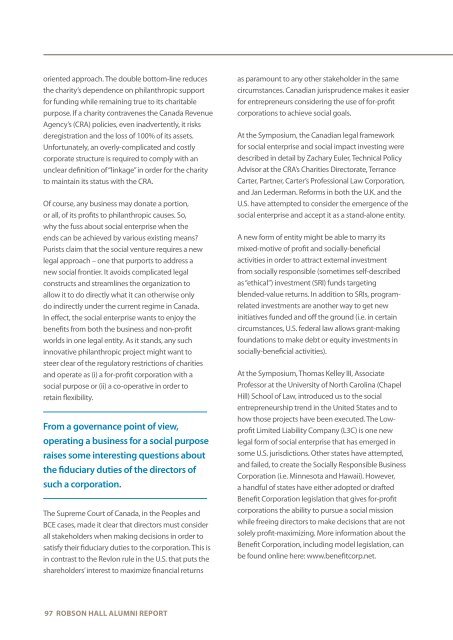downloading the PDF - Robson Hall Faculty of Law
downloading the PDF - Robson Hall Faculty of Law
downloading the PDF - Robson Hall Faculty of Law
Create successful ePaper yourself
Turn your PDF publications into a flip-book with our unique Google optimized e-Paper software.
oriented approach. The double bottom-line reduces<br />
<strong>the</strong> charity’s dependence on philanthropic support<br />
for funding while remaining true to its charitable<br />
purpose. If a charity contravenes <strong>the</strong> Canada Revenue<br />
Agency’s (CRA) policies, even inadvertently, it risks<br />
deregistration and <strong>the</strong> loss <strong>of</strong> 100% <strong>of</strong> its assets.<br />
Unfortunately, an overly-complicated and costly<br />
corporate structure is required to comply with an<br />
unclear definition <strong>of</strong> “linkage” in order for <strong>the</strong> charity<br />
to maintain its status with <strong>the</strong> CRA.<br />
Of course, any business may donate a portion,<br />
or all, <strong>of</strong> its pr<strong>of</strong>its to philanthropic causes. So,<br />
why <strong>the</strong> fuss about social enterprise when <strong>the</strong><br />
ends can be achieved by various existing means?<br />
Purists claim that <strong>the</strong> social venture requires a new<br />
legal approach – one that purports to address a<br />
new social frontier. It avoids complicated legal<br />
constructs and streamlines <strong>the</strong> organization to<br />
allow it to do directly what it can o<strong>the</strong>rwise only<br />
do indirectly under <strong>the</strong> current regime in Canada.<br />
In effect, <strong>the</strong> social enterprise wants to enjoy <strong>the</strong><br />
benefits from both <strong>the</strong> business and non-pr<strong>of</strong>it<br />
worlds in one legal entity. As it stands, any such<br />
innovative philanthropic project might want to<br />
steer clear <strong>of</strong> <strong>the</strong> regulatory restrictions <strong>of</strong> charities<br />
and operate as (i) a for-pr<strong>of</strong>it corporation with a<br />
social purpose or (ii) a co-operative in order to<br />
retain flexibility.<br />
From a governance point <strong>of</strong> view,<br />
operating a business for a social purpose<br />
raises some interesting questions about<br />
<strong>the</strong> fiduciary duties <strong>of</strong> <strong>the</strong> directors <strong>of</strong><br />
such a corporation.<br />
The Supreme Court <strong>of</strong> Canada, in <strong>the</strong> Peoples and<br />
BCE cases, made it clear that directors must consider<br />
all stakeholders when making decisions in order to<br />
satisfy <strong>the</strong>ir fiduciary duties to <strong>the</strong> corporation. This is<br />
in contrast to <strong>the</strong> Revlon rule in <strong>the</strong> U.S. that puts <strong>the</strong><br />
shareholders’ interest to maximize financial returns<br />
as paramount to any o<strong>the</strong>r stakeholder in <strong>the</strong> same<br />
circumstances. Canadian jurisprudence makes it easier<br />
for entrepreneurs considering <strong>the</strong> use <strong>of</strong> for-pr<strong>of</strong>it<br />
corporations to achieve social goals.<br />
At <strong>the</strong> Symposium, <strong>the</strong> Canadian legal framework<br />
for social enterprise and social impact investing were<br />
described in detail by Zachary Euler, Technical Policy<br />
Advisor at <strong>the</strong> CRA’s Charities Directorate, Terrance<br />
Carter, Partner, Carter’s Pr<strong>of</strong>essional <strong>Law</strong> Corporation,<br />
and Jan Lederman. Reforms in both <strong>the</strong> U.K. and <strong>the</strong><br />
U.S. have attempted to consider <strong>the</strong> emergence <strong>of</strong> <strong>the</strong><br />
social enterprise and accept it as a stand-alone entity.<br />
A new form <strong>of</strong> entity might be able to marry its<br />
mixed-motive <strong>of</strong> pr<strong>of</strong>it and socially-beneficial<br />
activities in order to attract external investment<br />
from socially responsible (sometimes self-described<br />
as “ethical”) investment (SRI) funds targeting<br />
blended-value returns. In addition to SRIs, programrelated<br />
investments are ano<strong>the</strong>r way to get new<br />
initiatives funded and <strong>of</strong>f <strong>the</strong> ground (i.e. in certain<br />
circumstances, U.S. federal law allows grant-making<br />
foundations to make debt or equity investments in<br />
socially-beneficial activities).<br />
At <strong>the</strong> Symposium, Thomas Kelley III, Associate<br />
Pr<strong>of</strong>essor at <strong>the</strong> University <strong>of</strong> North Carolina (Chapel<br />
Hill) School <strong>of</strong> <strong>Law</strong>, introduced us to <strong>the</strong> social<br />
entrepreneurship trend in <strong>the</strong> United States and to<br />
how those projects have been executed. The Lowpr<strong>of</strong>it<br />
Limited Liability Company (L3C) is one new<br />
legal form <strong>of</strong> social enterprise that has emerged in<br />
some U.S. jurisdictions. O<strong>the</strong>r states have attempted,<br />
and failed, to create <strong>the</strong> Socially Responsible Business<br />
Corporation (i.e. Minnesota and Hawaii). However,<br />
a handful <strong>of</strong> states have ei<strong>the</strong>r adopted or drafted<br />
Benefit Corporation legislation that gives for-pr<strong>of</strong>it<br />
corporations <strong>the</strong> ability to pursue a social mission<br />
while freeing directors to make decisions that are not<br />
solely pr<strong>of</strong>it-maximizing. More information about <strong>the</strong><br />
Benefit Corporation, including model legislation, can<br />
be found online here: www.benefitcorp.net.<br />
97 ROBSON HALL ALUMNI REPORT














